The AMD Radeon RX 5500 XT Review, Feat. Sapphire Pulse: Navi For 1080p
by Ryan Smith on December 12, 2019 9:00 AM ESTPower, Temperature, & Noise
Last, but not least of course, is our look at power, temperatures, and noise levels. While a high performing card is good in its own right, an excellent card can deliver great performance while also keeping power consumption and the resulting noise levels in check.
| Radeon Video Card Voltages | |||||
| 5700 Max | 5500 XT Max | 5700 Idle | 5500 XT Idle | ||
| 1.025v | 1.141v | 0.775v | 0.700v | ||
Back when the RX 5700 series launched, AMD’s voltages surprised me; the RX 5700 XT went as high as 1.2v on TSMC’s 7nm process. For better or worse, it looks like those voltages aren’t a fluke, as we see high voltages with the RX 5500 XT as well. In this case the card tops out at 1.141v, a not insubstantial decrease from the RX 5700 XT, though it’s still relatively high. AMD’s GPUs are still the only high-throughput GPU-like product we’ve seen voltages for on this process, so it’s hard to say whether this is a TSMC thing or an AMD thing. But either way, as AMD’s own voltage/frequency curve helpfully illustrates, the last couple of hundred MHz on the RX 5500 XT gets to be quite expensive in terms of power.
| Radeon Video Card Average Clockspeeds (Rounded to the Nearest 10MHz) |
|||
| Game | 5500 XT | 5700 | |
| Max Boost Clock | 1860MHz | 1750MHz | |
| Official Game Clock | 1717MHz | 1625MHz | |
| Tomb Raider | 1810MHz | 1680MHz | |
| F1 2019 | 1810MHz | 1650MHz | |
| Assassin's Creed | 1750MHz | 1700MHz | |
| Metro Exodus | 1800MHz | 1640MHz | |
| Strange Brigade | 1840MHz | 1660MHz | |
| Total War: TK | 1840MHz | 1690MHz | |
| The Division 2 | 1800MHz | 1630MHz | |
| Grand Theft Auto V | 1830MHz | 1690MHz | |
| Forza Horizon 4 | 1830MHz | 1700MHz | |
Despite that power cost, however, the RX 5500 XT manages to keep its clockspeeds rather high. Even without Sapphire’s higher power cap performance BIOS, their 8GB card is frequently at 1800MHz or better, putting it well ahead of AMD’s official game clock of 1717MHz. This means the card is running fairly close to its clockspeed limit – so Sapphire’s extra power doesn’t do a whole lot – but it also means the card is doing all of this on 130W (or less) of power.
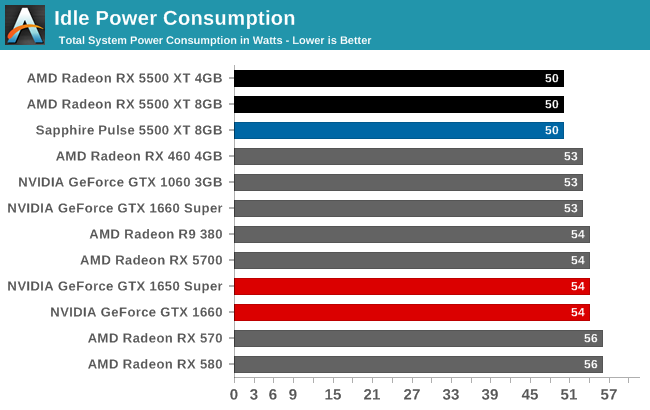
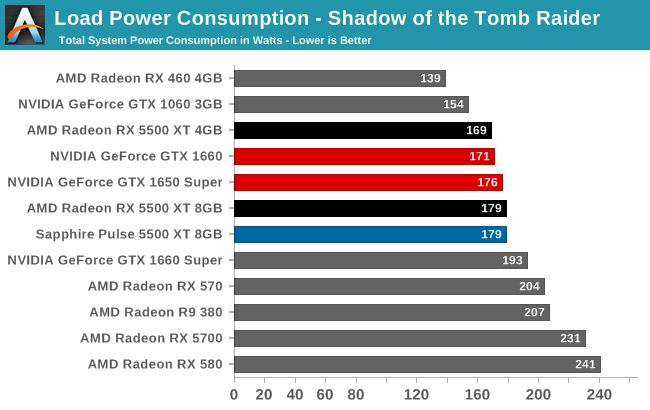
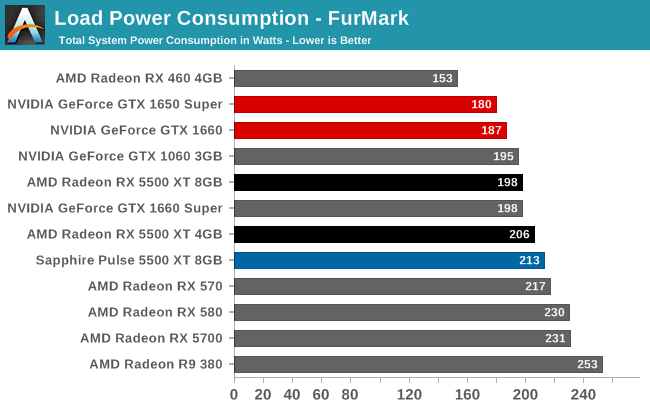
With the combination of TSMC’s 7nm process, AMD’s firmware optimizations, and I suspect the use of just 8 PCIe lanes, the RX 5500 XT fares very well when it comes to idle power. At 50W for the entire system, this is lower than any other configuration by a few watts. Which for idling, where power consumption is already low, is huge. No wonder Sapphire is able to offer zero fan speed idle here; the card is burning very little power at idle.
Similarly, load power is looking fairly good as well. Under Tomb Raider, the total system power consumption with the AMD cards is highly competitive with the NVIDIA competition (though as we’ve seen, actual game framerates trail a bit). Though AMD does fall behind under FurMark, as the 130W+ RX 5500 XT cards all have higher TDPs than NVIDIA’s 120W/125W equivalents, and FurMark will drive all of these cards to their power limits.
In practice, all of this generally reflects the cards’ relative specifications. The RX 5500 XT is able to hang with the somewhat inefficient GTX 1650 Super, however once we get to the more efficient GTX 1660, NVIDIA is consuming less power while delivering better performance.
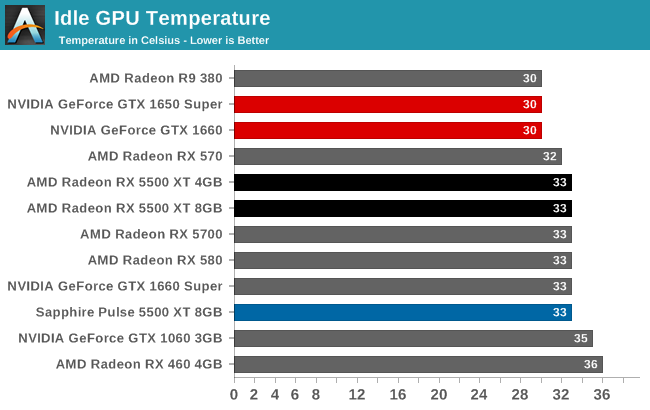


Early on I mentioned that Sapphire’s Pulse cards might be a bit overbuilt, and now that we’re getting into temperature and noise measurements, we get to see why. The idle GPU temperatures are what we’d expect for a zero fan speed idle card; meanwhile the load temperatures don’t crack 70C under Tomb Raider, and even FurMark only pushes the worst card to a well within tolerances 76C.
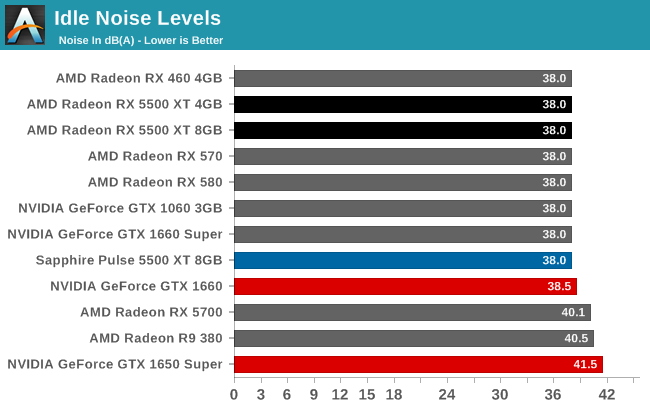
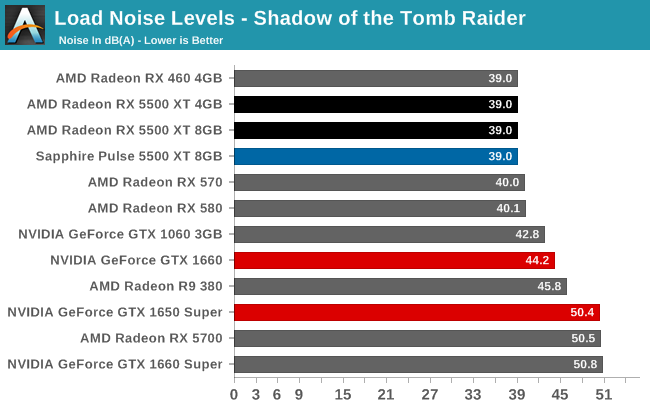
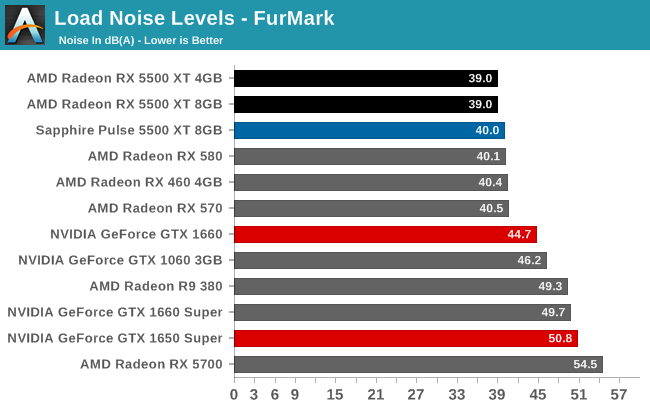
But when we get to noise, this is where Sapphire blows our socks off. Or rather, doesn’t blow our socks off?
The load noise levels I measured here were so low that it required extra effort to properly duplicate the results and isolate noise sources. With a card TDP of 130W, those big 95mm fans end up doing very little work. The PWM and monitoring-enabled fans run at under 800 RPM on gaming workloads, and it’s only when we’re using Sapphire’s higher TDP performance BIOS that the fans crack 1000 RPM.
Sapphire could probably cool a 200W card with this cooler, and I wouldn’t be too surprised to learn that it’s exactly such a card they took it from. But the net result is that while the card is a space hog, it’s a silent space hog. With load noise levels below 40 dB(A) for everything except FurMark, the card is barely louder than the rest of the system. Compared to our GeForce cards, all of which are smaller cards with equally small fans, the difference is extensive. Sapphire may have overbuilt their card, but as a result they’ve struck a great balance between temperatures and cooling performance, and delivering great acoustics in the process.


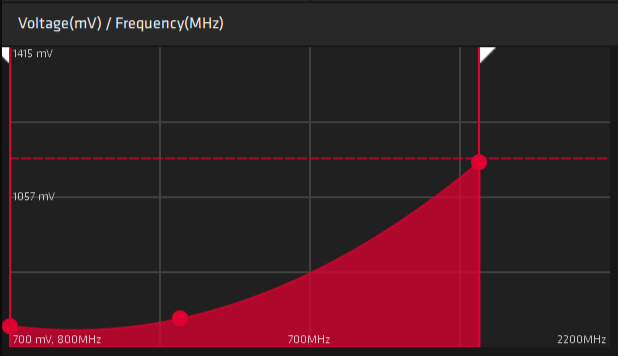








97 Comments
View All Comments
pcgpus - Friday, February 14, 2020 - link
Realy good comparasion of 5500XT and oponents is here:https://warmbit.blogspot.com/2020/01/rx5500xt-vs-g...
Smell This - Thursday, December 12, 2019 - link
{ snicker }
So ...
A cut-down GTX 1660 (TU116 - 284 mm2) with 6GB GDDR5 turns into a GTX 1650 (TU117 - 200 mm2) **Super** TU116 - 284 mm2 with 6GB GDDR6 ??
1) You've been "Played"; and
2) nVidia is going the wrong way.
Good luck with that.
silverblue - Thursday, December 12, 2019 - link
"Compared to AMD’s previous generation Polaris-based RX 500 series cards, the 1080p-focused RX 5500 XT delivers better performance""Competitive performance, meanwhile, is a bit of a trickier subject. As the replacements to the RX 570/580/590 within AMD’s stack, the RX 5500 XT almost always beats AMD’s older cards"
The elephant in the room here is the RX 590, at least in terms of gaming. In most titles, aside of those on page 6 as well as Total War in Ultra at 1080p, there doesn't appear to be enough of a gap between the 580 and 5500 XT to really set the latter apart. If we assume a somewhat standard RX 580 clocked at 1,340MHz/1,411MHz boost, the RX 590 could be 10% faster than this and would most likely beat the 5500 XT in a good number of cases. Additionally, Polaris looks like it has better 99 percentile performance.
drexnx - Thursday, December 12, 2019 - link
the 590 does look like it'll perform better, but it comes at a cost of about 100w more power - for some people this might not be an issue, for others it might be.PeachNCream - Thursday, December 12, 2019 - link
If you're building a new PC from scratch or have a lower wattage PSU in a system that is potentially getting an upgrade and the choise is between the RX 590 and the 5500 XT, the additional money spent on power delivery may tilt the cost versus benefit situation in favor of the 5500 XT. That 100W difference is significant enough to possibly cause that sort of problem.silverblue - Thursday, December 12, 2019 - link
Agreed with both of you.RSAUser - Friday, December 13, 2019 - link
Wattage isn't really an issue, a normal 450W will support the entire system. I'd still take the lower wattage part as less heat in the case so less fan spin.FreckledTrout - Friday, December 13, 2019 - link
A typical white box 300 watt PSU though and then you are left with one choice.HarryVoyager - Thursday, December 12, 2019 - link
Honestly, right now the real elephant are the used 580 8gb cards currently flooding the market. At $100, they're about equivalent to the 5500 XT, and have the 8Gb video memory the author is worried about. At this performance range, it's very hard to recommend someone spend 70-100+ more for pretty much the same real performance.The 5500 XT replaces the 580 at the low end, but doesn't really offer much that seems compelling over it.
I am hoping, however, that AMD can flesh out their competition next year with the Navi 2 cards. I'm seeing this as more of a Zen 1 launch. They're back in the game, and have a competitive foundation, and now they need to get it up to fighting trim.
Kangal - Friday, December 20, 2019 - link
Agreed.I'm excited about RDNA, but not completely sold on the new cards. I think the product lineup is what's most disappointing. For instance, if I wanted a Low Profile card, then I would have to go with Nvidia. If I wanted top performance, again Nvidia. And if I wanted mid-high segment, well Nvidia's New-Super range is quite competitive and then there's the older high-end Pascal cards. And if I wanted a low-mid segment, well now it's competing again with Nvidia's Super cards, older midrange Pascal cards, and now even older AMD Polaris cards.
The product line is very important, as well as marketing/sales, and these are both things that Nvidia absolutely gets right and dominates. After a decent 5 years, the new AMD is adapting, but they're not quite there yet. For instance, remember the launch of Pascal? Nvidia launched a high-end and a slight cut-down version, shortly after they released their mid-range version, then their low-power variants. After a year, they introduced their highest-end version, and make slight tweaks to improve the performance and efficiency of the entire product line. If AMD was able to imitate that, they would've released the RX 5800, and cut-down RX 5700. Then a month later it would be the RX 5600 and RX 5500. Then another month later it would be the RX 5400 (Low Profile) release. Then six months later all the cards would've gotten a slight refresh, maybe tag the "T" suffix at the end. And they would've also released the RX 5900T as their highest-end product.
So do NOT I see RDNA like Zen 1 at all, that was market disruptive, and it forced Intel to compete. Whilst Zen 1.1 put Intel on the backfoot. Eventually Zen 2 annihilated them. If anything, the RX 480 was Zen 1, it kept/forced Nvidia to be competitive with their GTX 1060 cards. The RX 5500XT is basically Zen 1.1, but it's still trying to keep up against Nvidia. For a Zen2-like scenario, AMD's next card needs to cost less, AND, perform much faster, AND, use less power.
I don't see that happening, as Nvidia improves their: architecture, drivers, ray-tracing, and moves unto the 7nm node. So when that happens, AMD is going to be on the backfoot again like they have been for a long time. For AMD to remain competitive they really need to release RDNA2 sooner rather than later, and have the entire product line ready to sell. Let's stay optimistic, and assume that is going to happen with more R&D thanks to the extra revenue AMD receives from: consoles, CPU, servers, and stock market : )